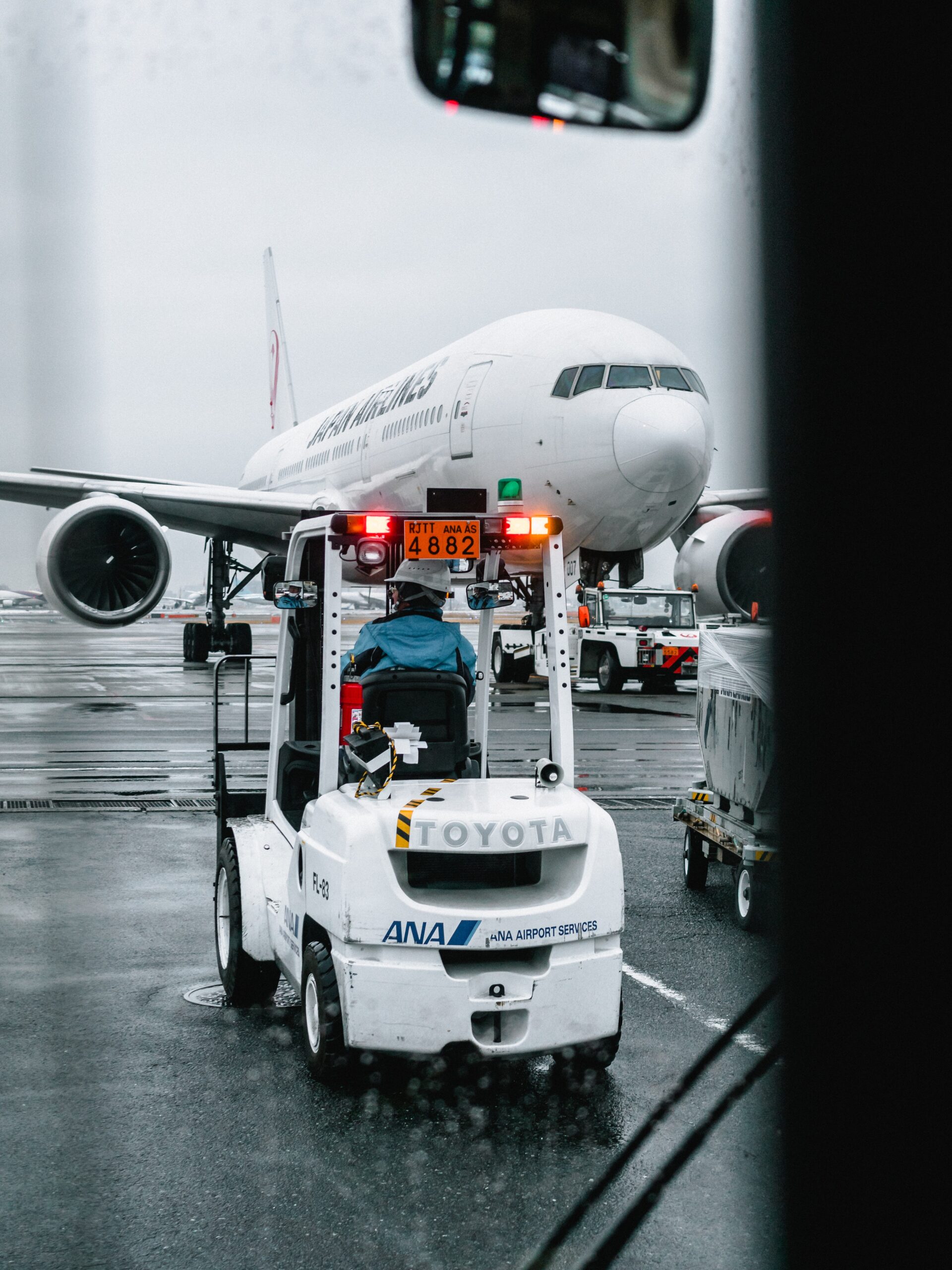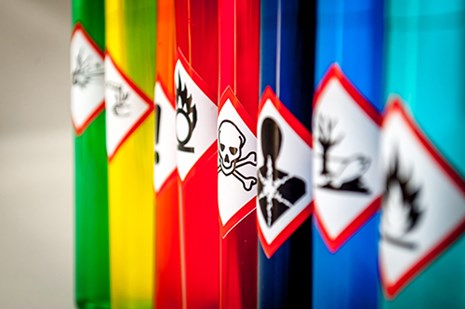
9 Dangerous Goods Classes and Hazard Labels
Each year, over 1.25 million shipments of hazardous materials are transported by air, and this number is expected to increase significantly with a projected annual growth of 4.9% in air cargo over the next five years. Given the substantial volume of these shipments, strict adherence to safety regulations is imperative. The International Air Transport Association (IATA) plays a crucial role in identifying risks, collaborating with the International Civil Aviation Organization (ICAO), and updating regulations to provide stakeholders with current guidelines for the safe handling and shipping of hazardous materials.
Hopefully our new Dangerous Goods page will provide all of the information that you need to keep you updated with the latest developments going forward. We will focus on the Dangerous Goods Classes in this post.
Defining Hazardous Materials
Before shipping, it’s essential to understand what constitutes hazardous materials. According to IATA’s Dangerous Goods Regulations (DGR) Manual, hazardous materials, also known as dangerous goods, are articles or substances capable of posing risks to health, safety, property, or the environment. These materials are listed in the IATA Dangerous Goods Regulations or classified according to these regulations. Strict adherence to IATA’s regulatory process ensures the safe and secure transport of hazardous materials by air.
Examples of Hazardous Materials
While experts in hazmat shipping are well-versed in transporting dangerous goods and dangerous goods classes, many travellers may not be aware of what falls into this category. Examples of hazardous materials include aerosols, lithium batteries, infectious substances, fireworks, dry ice, gasoline-powered engines, lighters, and paint.
Importance of Hazardous Materials Training
Safety is IATA’s top priority, necessitating mandatory training for all individuals involved in the supply chain—those who prepare, offer, accept, and handle hazardous materials. This training must be renewed every two years, and IATA facilitates easy access to it through courses and annual manuals, ensuring stakeholders stay updated on the latest rules and regulations.
IATA Dangerous Goods Regulations
The IATA Dangerous Goods Regulations consist of guidelines derived from the ICAO’s instructions for the safe transport of hazardous materials. Going beyond these entities’ safety protocols, IATA ensures the highest standards are followed.
Regular Updates of IATA Regulations
While ICAO updates its regulations every two years, IATA recognises the need for more frequent updates to address yearly changes and individual country and airline restrictions. Consequently, IATA updates its manual annually, incorporating the latest regulations and procedural changes.
Dangerous Goods Classes
The United Nations classifies hazardous materials into nine classes, each corresponding to specific hazards. These classes range from explosives and gases to flammable liquids, oxidising substances, toxic and infectious substances, radioactive materials, corrosives, and miscellaneous dangerous substances.
The transportation of dangerous goods by air is a complex process that involves meticulous adherence to safety regulations. One critical aspect of this process is the classification of hazardous materials into distinct categories, known as Dangerous Goods Classes. These dangerous goods classes provide a standardized way to identify and manage the diverse range of materials that pose potential risks during air transport. In this article, we will delve into the nine Dangerous Goods Classes, exploring their characteristics and the importance of proper classification in ensuring the safety of air cargo.
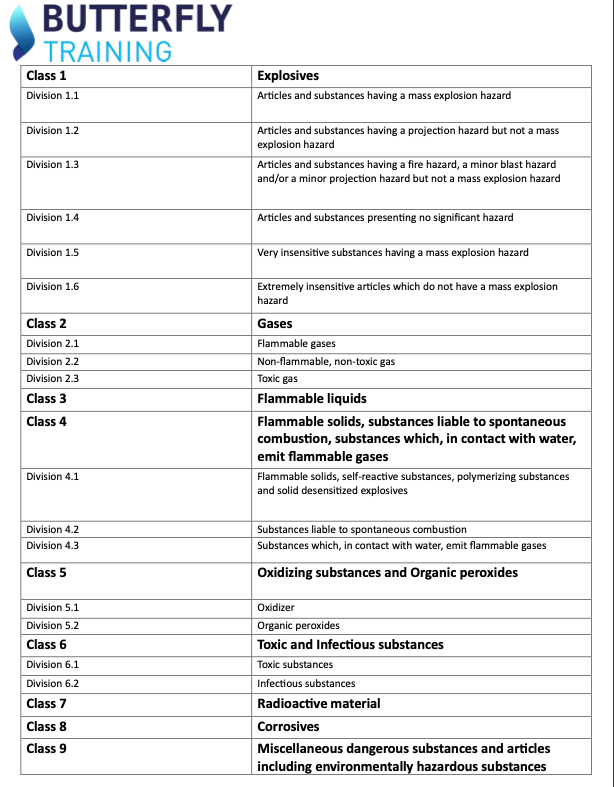
Dangerous Goods Class 1 – Explosives

The first class, Explosives, encompasses materials that can cause a sudden release of gas, heat, or both, resulting in a rapid expansion of gases. From fireworks to industrial explosives, Class 1 materials demand special handling and strict compliance with safety protocols to prevent accidental detonation.
This includes for example items such as:
- explosive substances
- pyrotechnic devices
- ammunition
- fireworks
- detonators.
Dangerous Goods Class 2 – Gases

Gases, the second class, includes materials that exist in a gaseous state at normal temperatures. This category encompasses flammable gases, non-flammable gases, and toxic gases. Proper containment and transportation procedures are crucial to prevent leaks or combustion during air transport.
These can be transported for example as:
- compressed
- liquefied
- refrigerated liquefied
- gas in solution.
This includes aerosols. Class 2 has 3 divisions:
- Division 2.1 – flammable gases such as:
- butane
- propane
- Division 2.2 – non-flammable, non-toxic gases such as:
- oxygen
- liquid nitrogen
- compressed air
- Division 2.3 – toxic gases such as:
- chlorine
- hydrogen sulphide.
Dangerous Goods Class 3 – Flammable Liquids
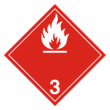
Flammable Liquids, the third class, covers materials prone to combustion. These liquids, such as fuels and solvents, require careful handling and secure packaging to prevent spillage and ignition during air transit.
This includes for example liquids with a boiling point of 35⁰ C or less, or a flash point of 60⁰ C or less such as:
- petrol
- alcohol
- perfumes
- essential oils
- hand sanitiser
- paints.
Dangerous Goods Class 4 – Flammable Solids; Substances Liable to Spontaneous Combustion; Substances that, in Contact with Water, Emit Flammable Gases

Class 4 is divided into three subcategories.
Division 4.1: Flammable solids
As for example :
- hexamine solid fuel tablets for camping stoves
- self-reactive substances
- desensitised explosives
Division 4.2: Substances liable to spontaneous combustion
As for example :
- camphor
- sulphur
- matches
Division 4.3: Substances which, in contact with water, emit flammable gases. Materials that release flammable gases when exposed to water. Proper packaging and segregation are essential to prevent interactions that could lead to fires or explosions.
As for example :
- sodium
- zinc particles
- activated carbon.
Dangerous Goods Class 5 – Oxidising Substances and Organic Peroxides

Oxidising Substances and Organic Peroxides, the fifth class, includes materials that provide oxygen, enhancing the combustion of other substances. These materials demand careful handling and separation to prevent reactions that could result in fires or explosions.
These substances are not necessarily combustible on their own but can react dangerously with other substances. Class 5 has 2 divisions:
- Division 5.1 – oxidising substances that may not be necessarily combustible, but they may readily yield oxygen and cause other materials to combust, such as for example :
- hydrogen peroxide
- ammonium nitrate
- potassium chlorate
- sodium nitrate
- Division 5.2 – organic peroxides are thermally unstable and can emit heat and give off harmful or flammable vapours. They can also be liable to explosive decomposition and react dangerously with other substances. Examples are:
- acetyl acetone peroxide
- benzoyl peroxide
- peracetic acid.
Dangerous Goods Class 6 – Toxic and Infectious Substances
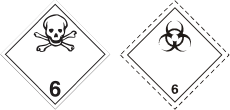
Class 6 encompasses Toxic and Infectious Substances. Toxic materials can cause harm through ingestion, inhalation, or skin contact, while infectious substances pose a threat due to their ability to spread diseases. Stringent regulations govern the transportation of these materials to protect both cargo handlers and the environment.
These substances can cause sickness, injury or death if consumed. Class 6 has 2 divisions:
- Division 6.1 – toxic substances that can cause death, injury or to harm human health if swallowed, inhaled or by skin contact, such as for example:
- chloroform
- arsenics
- cyanides
- cytotoxic waste
- barium compounds
- pesticides
- Division 6.2 – infectious substances that contain or are expected to contain pathogens that can cause disease in humans or animals, including:
- medical or clinical waste
- patient specimens
- genetically modified organisms
- infectious substances
- infected animals.
Dangerous Goods Class 7 – Radioactive Material

Radioactive Materials, the seventh class, includes substances emitting ionizing radiation. Strict controls are in place to ensure safe transport, preventing exposure to radiation and minimizing the risk of contamination.
It can cause objects such as aircraft and equipment to become contaminated if not packaged and handled correctly, such as for example:
- uranium
- radioactive ores
- isotypes
- radium
- cesium
- x-ray equipment
- medical equipment or parts.
Dangerous Goods Class 8 – Corrosives

Corrosives, the eighth class, covers materials that can cause severe damage to living tissue or other materials. Adequate packaging and labelling are crucial to prevent leaks and protect cargo handlers from harm.
These substances can cause irreversible damage if they come into contact with skin and could destroy other freight, or materially damage containers or aircraft. This includes for example:
- acids
- corrosive cleaners
- battery fluid
- formaldehyde
- hydrofluoric acid.
Dangerous Goods Class 9 – Miscellaneous Dangerous Substances and Articles, Including Environmentally Hazardous Substances

The final class, Miscellaneous Dangerous Substances, encompasses materials that don’t fit into the previous eight classes but still pose risks during air transport. This class includes environmentally hazardous substances, demanding special attention to prevent environmental contamination.
There are 2 types of handling labels – 1 for lithium battery shipments, and another for all other miscellaneous dangerous goods. This class includes:
- lithium batteries
- battery powered vehicles
- battery powered equipment
- first aid kids
- environmentally hazardous substances
- dry ice
- magnetised materials
- asbestos.
We are always available to discuss any questions about the Dangerous Goods Classes, please feel free to contact us using the details at the bottom of this post.
Identification of Hazardous Materials
Based on classification and composition, hazardous materials receive a UN number and a proper shipping name. IATA’s Dangerous Goods Regulation Manual includes a comprehensive list of around 3,000 articles and substances commonly shipped by air.
Shipping hazardous materials by air involves meticulous procedures. Shippers must declare their shipments as dangerous goods, complete a Dangerous Goods Declaration, and properly prepare the shipment. Operators then review these submissions against the Dangerous Goods Checklist to ensure compliance with regulations.
Top Three Hazardous Materials Shipped Annually
Out of the 1.25 million hazmat shipments, flammable liquids, dry ice, and lithium batteries emerge as the most commonly transported hazardous materials each year.
Responsibilities in Hazardous Materials Transportation
Proper training is crucial for all individuals in the hazardous materials supply chain, including shippers, freight forwarders, operators, ground handling agents, security screeners, and even cabin crew members. Each job function requires adherence to specific regulations and adequate training.
Infectious Substances and Lithium Batteries
Given the unique challenges posed by infectious substances and lithium batteries, IATA has developed specialised guidelines and manuals—the Infectious Substances Shipping Guidelines (ISSG) and the Lithium Battery Shipping Regulations (LBSR)—to assist shippers in complying with regulations.
Shipping and Handling Protocols
The safe transport of hazardous materials by air commences with proper shipping and handling. Shippers bear specific responsibilities, including complying with packaging requirements, using approved packaging, correctly assembling and securing packaging, adhering to quantity limits, ensuring contamination-free exteriors, and completing necessary documentation.
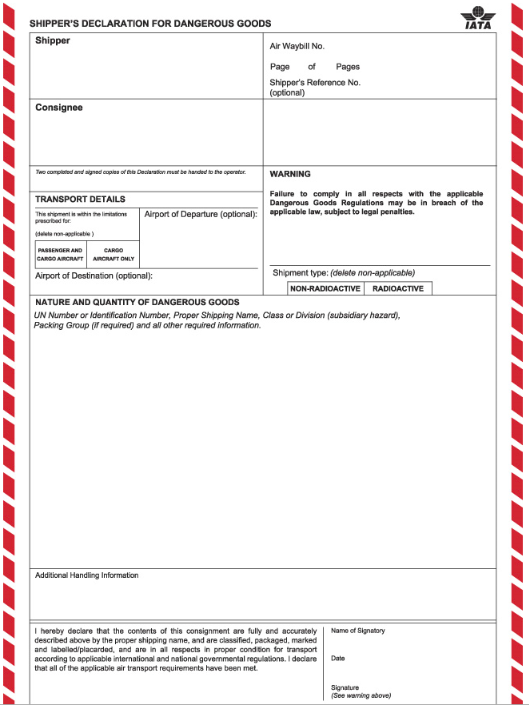
Preparing Hazardous Materials for Shipment
Proper preparation involves identifying hazardous materials, ensuring robust packaging, avoiding damage or leakage, preventing shifts during transport, and following IATA rules and regulations.
Completing a Dangerous Goods Declaration
Each hazardous material shipment requires a Shipper’s Declaration for Dangerous Goods and an Air Waybill. Precision in filling out these documents, including required information such as shipper and consignee details, nature and quantity of goods, and certification, is vital.
Documentation Responsibility
Shippers bear the responsibility of accurately completing the Shipper’s Declaration for Dangerous Goods, as inaccuracies can result in the rejection of goods for air shipment.
Latest Edition of IATA Dangerous Goods Regulations Manual
The 65th edition of IATA’s Dangerous Goods Regulations, effective from January 1, 2024, to December 31, 2025, includes changes made by the IATA Dangerous Goods Board and an appendix for upcoming ICAO Technical Instructions changes.
How long is a Dangerous Goods Certificate valid for?
A Dangerous Goods Certificate is valid for 24 months. This is the case for all DGR certifications.
Accessing More Information
IATA emphasises safety in air transport, providing quality training and regulatory manuals to ensure accessible safety regulations. Stakeholders can find the latest copy of IATA’s Dangerous Goods Regulations on the DGR page.
Conclusion
In conclusion, the air transportation of hazardous materials demands strict adherence to regulations, comprehensive training, and constant updates to ensure the safety of all involved parties. Understanding the Dangerous Goods Classes is paramount for all stakeholders involved in the air transport of hazardous materials. Proper classification ensures compliance with safety regulations, mitigating the risks associated with the diverse range of dangerous goods. By adhering to these classifications, the aviation industry can continue to uphold the highest safety standards in the transportation of goods across the globe.
As previously stated, we are always available to discuss any questions about the Dangerous Goods Classes, please feel free to contact us by clicking here. Our IATA certified instructors can assist with any questions that you or your organisation have on the various Dangerous Goods Classes.
We try to respond to queries within 24 hours and hopefully there will be a successful resolution to your query.
In the meantime, here is IATA’s former Head of Cargo Safety and Dangerous Goods to review the 65th edition of the International Air Transport Association (IATA) Dangerous Good Technical Instructions (including Dangerous Goods Classes). All of our training courses which cover dangerous goods classes have been updated with the Technical Instructions guidance from the 65th edition and we are happy to be appointed as an IATA Competency Based Training and Assessment (CBTA) Centre of Excellence again for the third year in a row.


